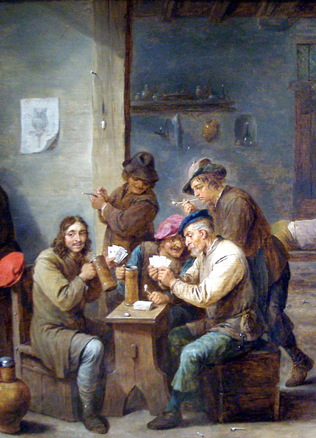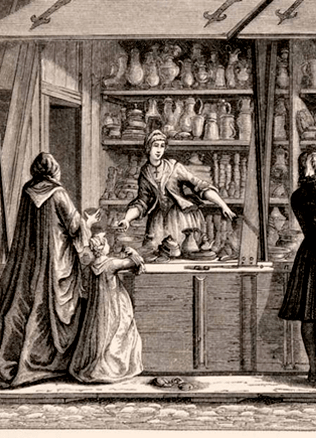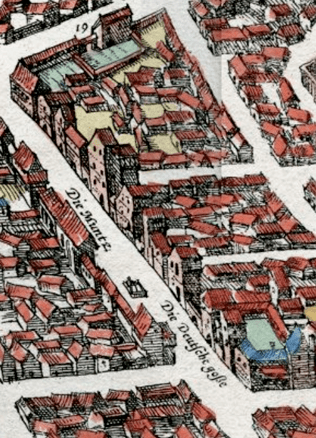Inns: the driving force of economy in Lithuanian towns of the 15th–mid-16th centuries
Inns in historical sources of Lithuania appeared during the time of great changes – the Baptism. From the end of the 14th century they were the most important constructions alongside churches and marketplaces. Throughout the 15th century, inns became a symbol of small towns where alcoholic beverages were made and sold. They were the ceaseless driving force of the town’s economy. As it is said, the door of the inn was always kept wide open.
From the ruler’s brewery to a public watering-hole
The first mention of the inns in the historical sources of Lithuania is found in Władysław II Jagiełło’s circular to the superintendents of the Ruler’s estates in 1389 in which they were instructed to provide the Catholic clergy who went to created parishes with the most necessary things and help: “And we also allow that each priest can build one inn (karczma) for himself, and let him build it.” Such an early mention allows us to suppose that inns existed in pagan times too. The term karczma is most often related to the Slavonic parent language. It is as though mentioned in the written sources of the 11th century already. Therefore, it is likely that it came to Lithuania in the 14th century, during the time of the state’s rapid expansion into the Ruthenian lands.
In the 16th century the inns had to be a constituent part of the Duke’s economy.
They were established in the places close to a castle and honey and corn collected from the peasants to the Duke’s storage were processed there. The largest part of mead and beer made from them went to the castle, but some part was left for the people who lived close to the castle. It is unlikely that in those days people traded in beverages of the inns intensely because coins of small value were needed for such trade, and they spread in Lithuania wider at the end of the 15th century only. The old theory of the historians also raises doubts, which says that as though inns evolved from the custom of a bargain celebration. That habit meant public drinking with witnesses after a thing had been acquired. However, it is hardly possible that all the purchases were celebrated by such drinking. Perhaps it was only in those cases when the price of the purchase was high, for example, when a large animal was purchased. If inns had been dependent on the scope of domestic trade, they would be out of work.
The inn business in small towns
The network of inns began to expand rapidly from the end of the 15th century.
The end of the reign of Casimir Jagiellon (1440–1492) is better reflected in the sources and they show that at that time the inns most often were the Ruler’s ownership. But when the Grand Duke granted holdings to the nobility and churches, alongside the estates and subordinates the inns had to get into the private hands. It was only at the beginning of the 16th century that the Rulers’ privileges are found more often, thereby the right to establish towns with markets and inns or build them on the roadsides was granted to private individuals.
The growth of the network of inns encouraged stricter regulation of their activities. The Chapter devoted to freedoms of the nobility (Section 3, Article 17) in the First Statute of Lithuania strictly instructs the state officials not to allow secret inns founded in out-of-the-way places (корчмы покутныи) to function. And where they functioned legally the state officials had to inspect their work so that the conditions specified in the founding documents should not be violated. Most likely that meant the order that had been formed much earlier according to which it was forbidden to sell home-made beverages rather than to produce them.
Do You Know?
In the first half of the 16th century there were no representatives of any other craft except the innkeepers in many towns of the Ruler. The house of every town-dweller was an inn. For example, in 1538, there were 33 houses of town-dwellers in Ariolaga: beer was brewed in 31 houses and in the remaining ones, including the house of the town’s Prefect, mead and bear were made. In the same year there were 9 houses in the small town of Žvingiai: beer was sold in eight of them, while mead and beer was sold in the ninth.
In the first half of the 16th century there were no representatives of any other craft except innkeepers in many towns of the Ruler. The house of every town-dweller had an inn. True, they differed in the kinds of beverages being sold, and different technologies were used in production of beverages. The oldest inns described sold both mead and beer. And from the middle of the 16th century the number of inns, in which vodka was sold was on the increase. For example, in 1538, there were 33 houses of town-dwellers in Ariolaga: beer was brewed in 31 houses and in the remaining ones, including the house of the town’s Prefect, mead and bear were made. In the same year there were 9 houses in the small town of Žvingiai: beer was sold in eight of them and mead and beer was sold in the ninth one. In 1556, the small town of Panevėžys was reorganised following the regulations of the volok reform and there were about 90 houses in it. More than 50 of them were inns: almost all of them sold beer, and only three of them sold beer and mead, and ten of them sold vodka alongside beer. The remaining inhabitants of Panevėžys were agricultural workers and market-gardeners. Furthermore, there were also 11 herdsmen (butchers). Hence, the abundance of inns was a distinguishing feature of the small towns. A large town, which claimed to grow into a city, was noted for the abundance of craftsmen and larger trade. Of course, there was no lack of inns in it either; however, their activities were not so conspicuous beside that of other enterprises.
Stories from the life of drunkards
The inside life of the inns is known from the hints of the inns only. In terms of buildings they did not differ much from dwelling houses. It is likely that these were larger houses with separate beverage production, sale and perhaps storing premises. The examples of the inns of the 19th century that have survived up to the present day allow us to make such a supposition. It seems that from the middle of the 16th century bedrooms for guests and separate premises for horses and carts had to appear next to these premises, especially in the roadside inns.
One of the earlier such cases is dated 1461 (or 1462). The dean of Nemenčinė and his family set off for Linkmenys to meet with the local dean. The peasants noticed the deans in Linkmenys inn and greeted them by drinking to their health. In return for that the deans bought some mead to the people. Treating themselves to it, two peasants got drunk and began to spill not only their beer but also that of the deans. The deans’ servants threw the drunkards out of the inn but the latter returned. A fight started and one of the peasants was beaten to death.
Another case of the 16th century tells us about the customs at table in more detail. Two acquaintances dropped in at the inn in Gardinas: a woman and a man. They were served beer in a jug, and they drank out of one cup. The man noticed that the woman, having drunk beer spat into the cup and having filled it with beer from the jug, offered it to him. An argument started over that, and later it was taken to court.
Inns were that economic organisation of small towns through which money flew. Therefore, despite the apprehensions of the intellectuals of Lithuania about the harm done by drinking, even uneducated noblemen were apt sooner to establish some more new inns than close down one of the existing ones.
Literature: J. Jurginis, Svaiginimasis ir jo smerkimas, To paties, Istorija ir kultūra, Vilnius, 1984, p. 202–210; Kraštas ir žmonės. Lietuvos geografiniai ir etnografiniai aprašymai, parengė J. Jurginis, A. Šidlauskas, Vilnius, 1988, p. 83.
Eugenijus Saviščevas



